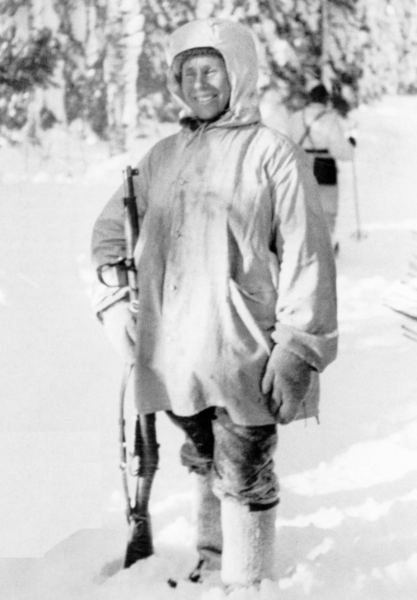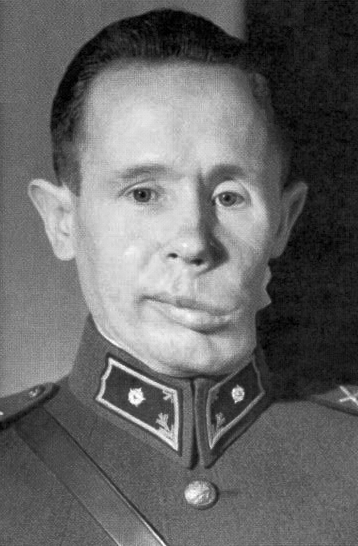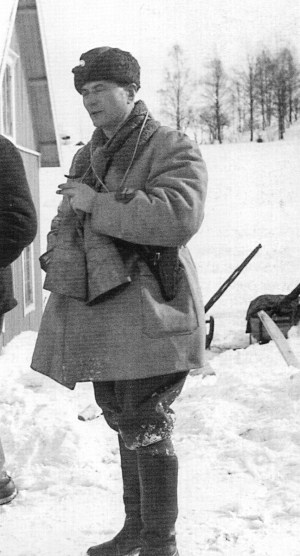<Back to Index>
- Alikersantti Simo "Valkoinen Kuolema" Häyhä, 1905
- Commander of the Jägerbattalion 4 Major Matti Armas "Motti - Matti" Aarnio, 1901
PAGE SPONSOR


Simo Häyhä (December 17, 1905 – April 1, 2002), nicknamed "White Death" (Russian: Белая смерть, Belaya Smert; Finnish: valkoinen kuolema; Swedish: den vita döden) by the Red Army, was a Finnish sniper. Using a modified Mosin – Nagant in the Winter War, he has the highest recorded number of confirmed sniper kills – 505 – in any major war.
Häyhä was born in the municipality of Rautjärvi near the present day border of Finland and Russia, and started his military service in 1925. Before entering combat, Häyhä was a farmer and a hunter. At the age of 17, he joined the Finnish militia suojeluskunta and succeeded with his sniping skills in shooting sports in the Viipuri province. His farmhouse was reportedly full of trophies for marksmanship.
During the Winter War (1939 – 1940), between Finland and the Soviet Union, he began his duty as a sniper and fought for the Finnish Army against the Red Army. In temperatures between −40 and −20 degrees Celsius, dressed completely in white camouflage, Häyhä was credited with 505 confirmed kills of Soviet soldiers. A daily account of the kills at Kollaa was conducted for the Finnish snipers. Besides his sniper kills, Häyhä was also credited with over 200 kills with a Suomi KP/-31 submachine gun. Remarkably, all of Häyhä's kills were accomplished in fewer than 100 days at a time of year with very short hours of daylight.
Häyhä used a Finnish militia variant, White Guard M/28 "Pystykorva" or "Spitz", of the Russian Mosin - Nagant rifle, because it suited his small frame (5 ft 3 in/1.60 m). He preferred to use iron sights rather than telescopic sights to present a smaller target (the sniper must raise his head higher when using a telescopic sight), for more reliable visibility (a telescopic sight's glass can fog up easily in cold weather), and aid concealment (sunlight glare in telescopic sight lenses can reveal a sniper's position). Another tactic used by Häyhä was to compact the snow in front of him so that the shot would not disturb the snow and reveal his position. He also kept snow in his mouth, so that the vapor of his breath would not give him away.
The Soviets tried several ploys to get rid of him, including counter - snipers and artillery strikes.
On March 6, 1940, Häyhä was shot in the lower left jaw by a
Russian soldier during combat. The bullet tumbled upon impact and exited
his head. He was picked up by fellow soldiers who said "half his head
was missing", but he was not dead: he regained consciousness on March
13, the day peace was declared. Shortly after the war Häyhä was promoted from alikersantti (corporal) to Second Lieutenant by Field Marshal Carl Gustaf Emil Mannerheim; no one else has gained rank so quickly in Finland's military history.
It took several years for Häyhä to recuperate from his wound. The bullet had crushed his jaw and blown off his left cheek. Nonetheless, he made a full recovery and became a successful moose hunter and dog breeder after World War II, and hunted with Finnish president Urho Kekkonen.
When
asked in 1998 how he had become such a good shooter, he answered,
"practice." When asked if he regretted killing so many people, he said
"I did what I was told to as well as I could." Simo Häyhä
spent his last years in Ruokolahti, a small village located in southeastern Finland, near the Russian border.

Matti Armas Aarnio, known as Motti - Matti (24 February 1901, Kouvola – 16 December 1984) was a Finnish military officer and a specialist in motti battles during the World War II.
Aarnio was a volunteer during the Finnish Civil War with White Guards at the Savonia Front. Later he participated to the Estonian War of Independence, the Latvian War of Independence and the Aunus expedition in East Karelia. Aarnio graduated from the Finnish military service in 1920 as a reserve officer. He graduated from the Kadettikoulu in 1926 and the Sotakorkeakoulu in 1933. Aarnio was promoted to captain in 1929 and served in the Foreign relations department of the General Staff.
During the Winter War, Aarnio was promoted to the rank of Major and he commanded the 4th Jaegerbattalion (JP 4) in the north of Lake Ladoga. His battalion became known for battles against encircled Red Army troops in the battle of Lementti. During these motti battles, Aarnio used his eight best battalions, including his own battalion. The tactics of Aarnio was to destroy mottis at night time and in close range which proved successful. Later he received the nickname "Motti - Matti".
During the Continuation War, Aarnio was the Commander of the 9th Jaeger Regiment. His regiment was successful during the Reconquest of Ladoga Karelia. Aarnio was then appointed the Commander of the 56th Jaeger Regiment in December 1941. Later in the Lapland War, he was the Commander of the 2nd Jaeger Battalion. In 1945, Aarnio emigrated from Finland and lived for several years in Venezuela. He returned to Finland in 1952 and worked in the insurance business.